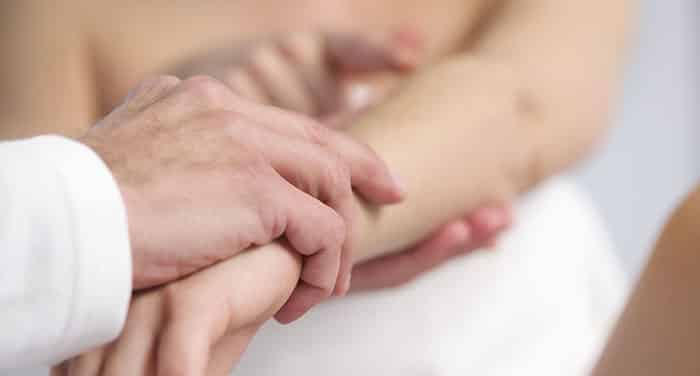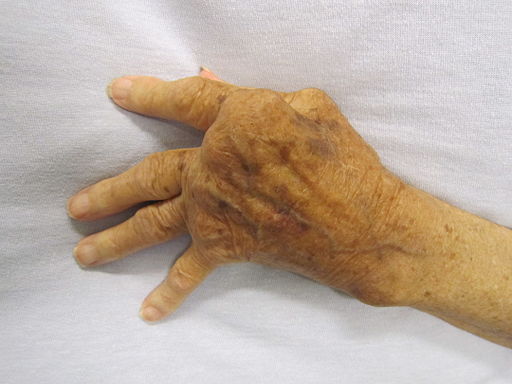
Pain in the hand (hand pain)
Pain in the hand and hand pain can hit everyone. Hand pain and pain in the hand can affect grip strength and quality of life. Pain in the hand can be caused by osteoarthritis overload, trauma, wear, Osteoarthrtitis, prolapse in the neck (can refer nerve pain down the arm to the hand), muscular malfunctions (e.g. extensor carpi myalgia) and mechanical dysfunction i joints - Carpal Tunnel Syndrome (also known as carpal tunnel syndrome), mouse arm or tennis elbow (lateral epicondylite) are possible diagnoses, but in many cases pain in the hand is transient and often related to overuse / misuse in everyday life. Please note that we recommend that you seek treatment if you suffer from prolonged or recurrent symptoms and pain in your hand. Otherwise you risk it getting worse. Feel free to contact us on Facebook if you have any questions or input.
Also read: 6 Exercises against Carpal Tunnel Syndrome
What can I do even for muscle and joint pain?
1. General exercise, specific exercise, stretching and activity are recommended, but stay within the pain limit. Two walks a day of 20-40 minutes make good for the whole body and sore muscles.
2. Trigger point / massage balls we strongly recommend - they come in different sizes so you can hit well even on all parts of the body. There is no better self help than this! We recommend the following (click the image below) - which is a complete set of 5 trigger point / massage balls in different sizes:
3. Training: Specific training with training tricks of various opponents (such as this complete set of 6 knits of different resistance) can help you train strength and function. Knit training often involves more specific training, which in turn can lead to more effective injury prevention and pain reduction.
4. Pain Relief - Cooling: Biofreeze is a natural product that can relieve pain by cooling the area gently. Cooling is especially recommended when the pain is very severe. When they have calmed down then heat treatment is recommended - it is therefore advisable to have both cooling and heating available.
5. Pain Relief - Heating: Warming up tight muscles can increase blood circulation and reduce pain. We recommend the following reusable hot / cold gasket (click here to read more about it) - which can be used both for cooling (can be frozen) and for heating (can be heated in the microwave).
Recommended products for pain relief for muscle and joint pain
Biofreeze (Cold / cryotherapy)
- No, for accept pain in your hands! Get them investigated!
Do not let pain in your hands and impaired function become part of your everyday life. Regardless of your situation, even if it is one with repetitive strain or a lot of sedentary office work for PC, it is so that you can always achieve better function than it is as of today. Our first recommendation for biomechanical pain is to seek out one of the three occupational groups that are publicly authorized through the health authorities:
- chiropractor
- manual therapist
- Physical therapist
Their public health authorization is a result of the authority's recognition of their extensive education and is a security for you as a patient and entails, among other things, several special benefits - such as protection through the Norwegian Patient Injury Compensation (NPE). It is a natural security to know that these occupational groups are registered in this scheme for patients - and we recommend, as mentioned, that one is investigated / treated by occupational groups with this associated scheme.
The first two occupational groups (chiropractor and manual therapist) also have the right to refer (to imaging diagnostics such as X-ray, MRI and CT - or referral to a rheumatologist or neurologist if needed for such an examination) and the right to report sick (may report sick if deemed necessary). Key words for improved musculoskeletal health mean more appropriate load in everyday life (ergonomic adjustment), generally more movement and less static sitting, as well as increased focus on regular exercise.
Also read: - 8 Good Exercises against tennis elbow / lateral epicondylitis
My hand is lazy. My hand is burning. My hand falls asleep. Cramp in the hand. The hand locks. Numbness in the hand. Wounds in the hand. Tingling in the hand. Itching in the hand. The hand is weak. The hand sticks and ants.
These are all symptoms that a clinician may hear from patients. We recommend that you map your hand pain well before going to your clinician (which you should definitely do for prolonged hand pain). Think about frequency (how often have you hurt your hand?), Duration (how long does the pain last? Is it constant pain?), Intensity (on a pain scale of 1-10, how bad is it at worst? And how bad is it? usually?).
Other commonly reported symptoms and problems
Over the years, our readers have come up with many different questions in the comments field, social media and our free counseling service on hand pain and hand pain. Here are some of the most common symptoms and things people wonder about in the hand or in the hands.
- Pain in the hand from using mobile, computer mouse and keyboard (If you get hurt in the hand and wrist from texting on your cell phone, using the computer mouse, and typing on the keyboard, this is a clear signal that you are doing this too much without sufficient muscle capacity to do this. Repetitive strain over time , without the body's natural ability to repair time-worn tendons and muscle fibers, can result in strain injuries. Some examples of strain injuries are mouse arm, tennis elbow / lateral epicondylite og Carpal Tunnel Syndrome. If you spend a lot of time on data, then it is important that you also spend time on recovery and custom training / stretching to withstand this strain. These exercises can be helpful.)
- Pain in the hand of writing (Writing with a pen or pencil is actually a rather complex movement that uses a lot of muscle. These are - in these modern times - muscles we are often not used to using in this way anymore. Too much writing can therefore result in writing cramps, congestion and pain in the hand - sometimes it can feel like a cramp that needs to be shaken loose before it comes in. Getting a sore hand from writing can also be an early sign of incipient dysfunction which - in the absence of exercise / treatment - can result in ailments such as Carpal Tunnel Syndrome.)
The most common cause of hand pain is a combination of muscle and joint dysfunction. This can involve tight, sore muscles (often called myalgias or muscle knots), as well as joint restrictions (often called 'locks' in the vernacular) in affected joint areas. Faulty loads over time or sudden overload can result in decreased movement and pain. Such incorrect loads can also result in nerve irritation or nerve compression - e.g. of the median nerve that runs from the neck, through the arm and out into the hand. Hand pain can also be due to referred pain from active muscle knots / myalgias.
Muscle nodules never occur alone, but are almost always part of the problem - this is because muscles and joints cannot move independently of one another. So it's never "just muscular" - there are always several factors that make you ache. Therefore, it is very important to examine and treat both muscles and joints to achieve normal movement pattern and function.
Extensor carpi radialis longus (wrist puller)) is one of several myalgias that can cause referred pain to the hand. Use the menu on the left to look at other myalgias that may refer to pain in the hand and wrist.
Time classification of pain in the hand. Hand pain can be divided into acute, subacute and chronic pain. Acute hand pain means that the person has had pain in the hand for less than three weeks, subacute is the period from three weeks to three months and the pain that has a duration of more than three months is classified as chronic.
Other diagnoses that can cause hand pain
Osteoarthritis (osteoarthritis and joint wear can cause pain in the areas affected by the hand - but can also be asymptomatic)
Inflammation of the hand (local swelling, reddened skin and pressure pain)
Extensor carpi radialis brevis myalgia (can refer pain to the upper hand and wrist)
Extensor carpi radialis longus myalgia (may refer to elbow and wrist pain)
Extensor carpi ulnaris myalgia (can refer pain to the wrist and further into the small finger / hypotension)
Flexor carpi radialis myalgia (can refer pain to the front of the base of the thumb and on into the hand)
Flexor carpi ulnaris myalgia (can refer pain to the front of the base of the little finger and on into the hand)
Karpaltunnelsyndrom (gives characteristic pain in the hand and wrist - especially pain in the thumb, index finger, middle finger and half ring finger)
Joint locker in neck and thoracic spine, ribs and / or between shoulder blades (interscapular)
muscle Knots / myalgia of the arm, shoulder and / or neck:
Active trigger points will cause pain all the time from the muscle (eg scalenii myalgi)
Latent trigger points provides pain through pressure, activity and strain
Palmaris longus myalgia (can cause forearm pain and further into the hand)
Prolapse in the neck (depending on which nerve root is affected - this can cause sensory and motor changes associated with that nerve)
Pronator Quadratus myalgi (may cause pain in the front of the wrist - like "a band")
Radial bursitis (hand mucosal inflammation)
Spinal Stenosis of the Neck (pain and symptoms may depend on which nerve root is pinched)
Hand pain can be caused by muscular tension, tendon injuries, joint dysfunction and / or irritation of distal or nearby nerves (narrow nerve passages). A publicly authorized clinician for musculoskeletal and nerve disorders can diagnose your ailment and give you a thorough explanation of what can be done in the form of treatment and what you can do on your own. Make sure that you do not have pain in your hand for a long time - this can make it more difficult to handle - rather contact a clinician and diagnose the cause of the pain so that you know what needs to be done.
Rheumatism can affect the hand as illustrated in the following image where the person is affected by advanced rheumatoid arthritis:
Manual treatment: Clinically proven effect on the relief of hand pain in carpal tunnel syndrome (KTS).
An RCT research study (Davis et al 1998) showed that chiropractic treatment had good symptom relief effect. Good improvement in nerve function, finger sensory and general comfort was reported. The methods chiropractors use to treat KTS include chiropractic adjustments of the wrist and elbow joints, muscle work / trigger point work, dry-needling, ultrasound therapy and / or wrist supports.
As mentioned earlier, both chiropractor and manual therapist are the occupational groups with the longest education and public authorization from the health authorities - that is why these therapists (including physiotherapists) see the majority of patients with muscle and joint ailments. The main goal of all manual treatment is to reduce pain, promote general health and increased quality of life by restoring normal function in the musculoskeletal system and nervous system. In case of musculoskeletal disorders, the clinician will both treat the hands locally to reduce pain, reduce irritation and increase blood supply, as well as restore normal movement in areas affected by dysfunction in joints - this can be e.g. neck, elbow and shoulder. When choosing a treatment strategy for the individual patient, the publicly authorized clinician places emphasis on seeing the patient in a holistic context. If there is a suspicion that the pain is due to another disease, you will be referred for further examination.
Manual processing (fraw chiropractor or manual therapist) consists of a number of treatment methods where the therapist mainly uses the hands to restore normal function in joints, muscles, connective tissue and nervous system:
- Specific joint treatment
- Stretches
- Muscular techniques
- Neurological techniques
- Stabilizing exercise
- Exercises, advice and guidance
What does a chiropractor or manual therapist do?
Muscle, joint and nerve pain: These are things that a chiropractor or manual therapist can help prevent and treat. Chiropractic / manual therapy is mainly about restoring movement and joint function that may be impaired by mechanical pain.
This is done by so-called joint correction or manipulation techniques, as well as joint mobilization, stretching techniques, and muscular work (such as trigger point therapy and deep soft tissue work) on the involved muscles. With increased function and less pain, it may be easier for individuals to engage in physical activity, which in turn will have a positive effect on both energy and health.
Exercises, training and ergonomic considerations
An expert in muscle and skeletal disorders can, based on your diagnosis, inform you of the ergonomic considerations you need to take to prevent further damage, thus ensuring the fastest possible healing time. After the acute part of the pain is over, in most cases you will also be assigned home exercises that also help to reduce the chance of relapse.
- Here you will find an overview and list of exercises we have published in connection with the prevention, prevention and relief of hand pain, hand pain, stiff wrist, osteoarthritis and other relevant diagnoses.
Overview - Exercise and exercises for hand pain and hand pain
6 Effective Exercises against Carpal Tunnel Syndrome
7 Exercises against Sore Shoulder
- Make stretching exercises of hands and fingers before starting work and repeat this throughout the work day.
- Map everyday life. Find the things that cause you pain, and make changes to their performance.
- Make the workplace ergonomic. Get a raise and lower desk, a better chair and wrist rest. Make sure your hands are not bent backwards for most of the day, for example if you have a computer keyboard that is not in the correct position in relation to your working position.
- We recommend that you buy the following: Gel-filled wrist rest, gel-filled mouse pad og ergonomic keyboard (can be customized).
Recommended products for effective training
Other commonly reported symptoms and causes of pain in the hands and pain in the hands
- Pain in the hands after alcohol
- Pain in hands after crutches
- Pain in hands after cycling
- Pain in hands after exercise
- Pain in hands and arms
- Pain in hands and fingers
- Pain in hands and feet
- Pain in hands and pregnant
- Pain in the hands and swelling
- Pain in hands and knees
- Pain in hands and forearms
- Pain in the hands of the morn
- Pain in the hands at night
- Pain in hand after fracture
- Pain in hand after fall
- Pain in the hand after a wrist fracture
- Pain in the hand after surgery
- Pain in hand after stroke
- Pain in the hand after venous fibrillation
NEXT PAGE: - What You Should Know About Carpal Tunnel Syndrome
Also read:
- Osteoarthritis (learn more about joint wear)
- Glucosamine sulfate against osteoarthritis? (can glucosamine sulfate prevent wear?)
- Exercises for tennis elbow / lateral epicondylitis?
References:
- Davis PT, Hulbert JR, Kassak KM, Meyer JJ. Comparative efficacy of conservative medical and chiropractic treatments for carpal tunnel syndrome: a randomized clinical trial. J Manipulative Physiol Ther. 1998;21(5):317-326.
- Punnett, L. et al. A Conceptual Framework for Integrating Workplace Health Promotion and Occupational Ergonomics Programs. Public Health Rep. , 2009; 124 (Suppl 1): 16–25.
Frequently Asked Questions:
Q: Can the pain on top of the hand be due to carpal tunnel syndrome / carpal tunnel?
Yes, carpal tunnel syndrome can cause pain on the front, back, top and sides (both left and right side) of the hand. This is because carpal tunnel often causes a nerve irritation that can cause referred pain - and we must also keep in mind that such a diagnosis rarely comes alone, so we will probably see clear dysfunction in the elbow and nearby muscles that can also refer pain to the upper hand. We recommend that you stretch regularly and receive treatment for both hand, wrist and elbow. Contact us if you need a recommendation from a clinician who is a hand specialist.

















Help!
I'm trying to find a leather strap orthosis for a patient who has trouble with intercarpal ligaments in his hand after a fracture. They must have had this before on e.g. bandagist, and I have tried to find in various online stores without success. It is smaller than several other wrist protectors / orthoses and therefore made of leather.
All tips are received with thanks!